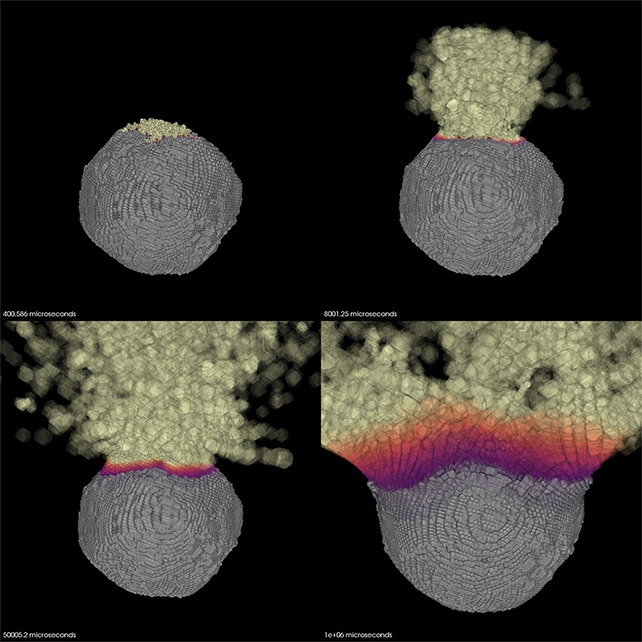
While it has been a favorite disaster movie theme, nuking an incoming asteroid in the real world has been touted as a very bad idea.
While a nuclear bomb could possibly obliterate a smaller asteroid, nuking a larger asteroid would only break it into pieces. Those pieces would still threaten our planet, and perhaps even makes things worse by producing multiple impacts across the planet.
But is using nuclear weapons on an incoming asteroid really a bad idea? If the right technique is used, a nuclear blast could possibly be used as an asteroid deflection device.
Researchers at Lawrence Livermore National Laboratory (LLNL) have now created a modeling tool that can simulate what might happen if a nuclear device is detonated above the surface of an asteroid. The tool is helping to improve the understanding of how the radiation from a nuclear blast interacts with an asteroid’s surface, and also looks at the shockwave dynamics that might affect the inner asteroid.
The explosive technique called nuclear ablation, where the blast’s radiation would vaporize part of the asteroid’s surface, generating an explosive thrust and a change in velocity in response.

The model can incorporate a wide range of initial conditions which simulate the kinds of asteroids we’ve recently been able to study up close, from solid rocks to rubble piles. These simulations are giving planetary scientists more insights – and more options – for when a space rock might one day be bearing down on Earth.
“If we have enough warning time, we could potentially launch a nuclear device, sending it millions of miles away to an asteroid that is headed toward Earth,” said researcher Mary Burkey from LLNL.
“We would then detonate the device and either deflect the asteroid, keeping it intact but providing a controlled push away from Earth, or we could disrupt the asteroid, breaking it up into small, fast-moving fragments that would also miss the planet.”
Thanks to the Double Asteroid Redirection Test (DART) mission – where a kinetic impactor was deliberately crashed into an asteroid to alter its trajectory – scientists have learned much about what it would take to redirect a dangerous asteroid. This new model, called the X-ray energy deposition model, gives researchers the tools to build upon the insights gained from DART while exploring how nuclear ablation could be a viable alternative to kinetic impact missions.
Burkey said in a LLNL press release that nuclear devices have the highest ratio of energy density per unit of mass of any human technology, which could make them an invaluable tool in mitigating asteroid threats.
But, as the team wrote in their paper, published in The Planetary Science Journal, “predicting the effectiveness of a potential nuclear deflection or disruption mission depends on accurate multiphysics simulations of the device’s X-ray energy deposition into the asteroid and the resulting material ablation.”
The team said the relevant physics in these simulations require a variety of different complex physics packages, they span many orders of magnitude and are computationally very demanding. Burkey and her colleagues set the goal of developing an efficient and accurate way of modeling nuclear deflection for a range of physical properties of an asteroid.
Burkey said that their high-fidelity simulations can track photons penetrating surfaces of asteroid-like materials such as rock, iron, and ice, while accounting for more complex processes, such as reradiation.
The model also considers a wide variety of asteroid bodies. They said this comprehensive approach makes the model applicable to a wide range of potential asteroid scenarios.
If a real planetary defense emergency should arise, Megan Bruck Syal, LLNL’s planetary defense project lead, said this high-fidelity simulation modeling will be critical in providing decision-makers with actionable, risk-informed information that could prevent asteroid impact, protect essential infrastructure and save lives, explained.
“While the probability of a large asteroid impact during our lifetime is low, the potential consequences could be devastating,” Bruck Syal said.
This article was originally published by Universe Today. Read the original article.

